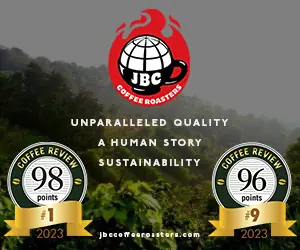Courtesy of Kenneth Davids, 21st Century Coffee: A Guide
South-central India is the home of some of the world’s loveliest coffee farms: rich, dense, complexly poetic coffee landscapes. Enormous, often ancient trees — ficus, mahogany — spread to form the highest tier of these coffee-centric forests. Fruit trees and younger, slender trees that are periodically harvested for timber form a middle tier, all shading the coffee trees in the lowest tier. Black pepper vines festoon the tree trunks. It is a landscape in which the hand of the farmer and the exuberance of nature seem to fit together with lush, casual grace.
Many Indian coffee landscapes are simpler, with only one or two species of tree providing a single tier of shade, but there are usually fruit trees, usually intercropping, always the ubiquitous black pepper vines wrapping around and softening the lines of tree trunks.
Equal Treatment for Arabicas and Robustas.
These old, impressive farms of southern India produce coffees of both the Arabica and the Robusta species. The same dedicated care and environmental sensitivity is typically lavished on farms that grow Robusta as on those dedicated to Arabica. This is one reason India Robustas are among the world’s finest, matched only by some of the great Robustas of Uganda, the original home of the species.
These scenic farms also practice meticulous versions of traditional ferment-and-wash processing and sun drying. In other words, despite the large size of many Indian farms, their harvest, fruit-removal and drying processes remain stubbornly artisan and obsessively meticulous.
Why Underappreciated?
Given this rich devotion to the practice of fine coffee, why are India Arabicas not more celebrated and admired? In the U.S. one hardly sees them on specialty websites or in stores. They appear on the specialty scene more frequently in parts of Europe, but even there they seldom show up presented with the celebrity that beautiful farms and meticulous artisan coffee practice would seem to merit.
The Variety Limitation.
The difficulty with India Arabicas is the same limitation that haunts many of the world’s underappreciated coffee origins: tree varieties are simply not particularly distinctive in the cup. India has been particularly hard hit over the decades by leaf rust, so much so that almost no pure Arabica varieties are grown there. Aside from rare stands of Kent, a respected pure Arabica variety selected in the 1920s, almost all widely grown Indian varieties are hybrids incorporating genetic material either from Robusta or from another taste-suspect species, Liberica.
Consequently, Indian Arabicas are likely to be very clean in profile owing to meticulous harvesting and processing, moderate in acidity owing to medium to medium-high growing elevations, yet usually not particularly distinctive in aroma and flavor owing to the impact of neutral- tasting hybrid tree varieties. One widely grown hybrid, Selection 9 (Sln 9), does incorporate genetic material from a native Ethiopian variety called Tafarikela on the Arabica side of its heritage. Depending on year and farm, Selection 9 can display a lovely and distinctively elegant floral-and-fruit delicacy. Additionally, many Indian growers are experimenting, often quite successfully, with alternative processing methods.
India Growing Regions
The Coffee Board of India has meticulously defined and branded its coffee-growing regions. These regions may differ in the predominant ethnicity of the producers, or the average size of farms, or in general tendencies in terroir. But these differences do not seem to have sufficient impact on cup character to override overall similarities of tree variety and processing method on one hand, or more farm-specific differences related to microclimate and processing variations on the other.
Nevertheless, for coffee geographers, a useful general way of thinking about India coffee-growing regions is to divide them as follows.
Older, Traditional Regions.
These comprise India’s coffee heartland and produce the majority of India’s coffees. They include the admired growing regions of south-central India in the states of Karnataka, Kerala and Tamil Nadu. Coorg and Chikmagalur are particularly well known and productive. Farms tend to be old, large and traditional.
Newer and Less-Traditional Regions.
Araku Valley, in the mountains near the Indian Ocean at the border between the states of Orissa and Andra Pradesh, is the most interesting of these newer regions. There is also coffee growing dispersed among the mainly tea-growing regions of far northeastern India. In both cases, production is mainly carried out by small-holding producers rather than on large, traditional farms as is the case in the classic growing regions of south-central India.
The Araku Valley project was funded by a private foundation with government and local support. The project goal is to preserve native forests and improve the standard of living for nomadic tribal peoples who traditionally practice an ecologically destructive cut-and-burn agriculture. The project aims at persuading these people to settle down in villages and become small-holding coffee farmers. Some coffees are produced from trees of the often delicately fruit-and-floral Sln 9 variety, with dense beans owing to cool night temperatures mimicking high growing elevations.
The Traditional India Cup
Typical Global Descriptors.
Straightforward and direct, clean, sweetly bright and balanced. When the coffee is produced from trees of the Ethiopia-related cultivar Selection 9 (Sln 9), more emphasis on flowers and clean fruit, greater delicacy.
Common Aroma/Flavor Notes (top specialty lots).
Nut, baking chocolate, ripe citrus (orange, tangerine), hints of aromatic wood and sweet flowers. The flowers, citrus and cocoa-ish chocolate may be more prominent in lots from trees of the Sln 9 variety.










